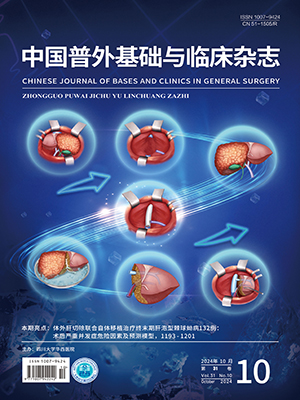Objective To investigate the effect of TIMP-2 gene that was transfected by adenovirus on extracellular matrix of abdominal aortic through assessing the changes of morphology and histopathology of the rat models with abdominal aortic aneurysm.
Methods The rat models with abdominal aortic aneurysm were constructed by intraluminally perfusing porcine pancreatic elastase. Twenty-four SD rats with aneurysm were then randomly divided into 3 groups: AdTIMP-2 group (perfused locally with solution of TIMP-2 gene transfected by adenovirus vector to abdominal aorta), AdCMV group (transfected by non-viral vector), and PBS group. After 14 days, the concentrations of elastin and collagen that were collected from the samples of aortic wall were measured by image analysis system and the fixed aortic tissues were examined by light microscopy and some other specific staining methods.
Results None of abdominal aortic aneurysm developed in TIMP-2 gene transfected group, with significantly higher rates of developed aneurysm in the other groups (P<0.01). The diameters of arteries on day 14 in the AdTIMP-2 group were (2.33±0.06) mm, which were significantly smaller than those in the AdCMV group 〔(3.52±0.11) mm〕 and PBS group 〔(3.43±0.09) mm〕. The elastic fibers and collagenous fibers were preserved with more integrity in AdTIMP-2 group and inflammation cells that were observed in adventitia of artery were also less than those of the other groups.
Conclusion TIMP-2 gene transfected by adenovirus vector could restore the degradation of extracellular matrix that was aroused by elastase and could block the formation of abdominal aortic aneurysm, which may provide a new strategy for the treatment of abdominal aortic aneurysm.
Citation: ZHAO Xin,ZHANG Peirui,YU Xianghai,LIAO Mingfang,ZHANG Suzhen,JING Zaiping. Experimental Study of Inhibiting Effect of TIMP-2 Gene Transfected by Adenovirus on Extracellular Matrix of Rat Abdominal Aorta. CHINESE JOURNAL OF BASES AND CLINICS IN GENERAL SURGERY, 2007, 14(3): 276-279. doi: Copy




